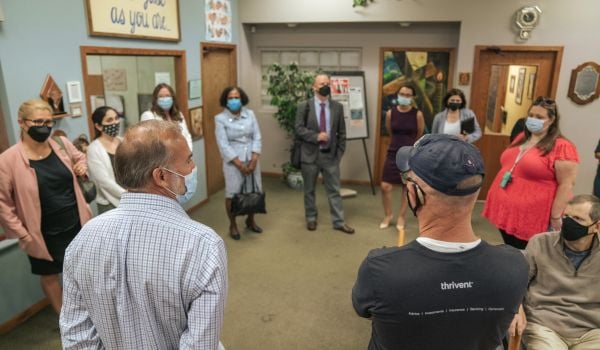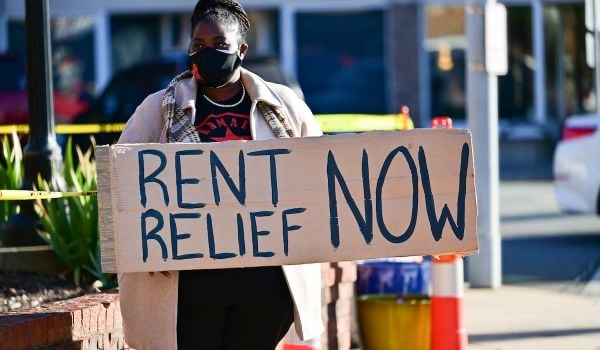There’s a story often told about Angie Walker, the homeless program coordinator in the city of Rockford, Illinois, a city of 150,000 people about 85 miles northwest of Chicago. In addressing Rockford’s population of chronically homeless individuals, she got to know a man who had lived on the streets for several years, resisting efforts to be housed.
In one of her visits, he expressed disappointment he couldn’t watch the Chicago Cubs play in the upcoming World Series without television. Walker made an offer on the spot: if he agreed to housing in a nearby short-term residency hotel, there’d also be television to watch baseball. He agreed. After the Cubs’ historic win, the pair worked together to eventually secure a more permanent living arrangement.
The story resonates because it’s the kind of determination, creativity and personalized service that’s come to define Rockford’s work with homeless individuals. Since 2014 — when the Obama administration called on U.S. mayors to end veteran homelessness — the city’s Human Services Department has “changed its entire system — everything we do,” according to Walker, to reduce its homeless population to “functional zero.”
Functional zero technically means that the number of people who are homeless is no greater than the monthly housing placement rate. More generally it’s understood as a well-coordinated, data-driven effort that assures homelessness is rare, brief and non-recurring, with no one forced to live on the street.
After Rockford brought veteran homelessness to functional zero, the city did the same for its chronically homeless population. Next was youth homelessness, which Walker expects to bring to functional zero in the coming months. The city’s final focus, to be addressed through 2020, is on single individuals and families experiencing homelessness.
Walker’s efforts trace back to two different initiatives emerging around the same time. The first was the Mayor’s Challenge to End Veteran Homelessness launched by the Obama administration, which prompted Walker to email then-mayor Lawrence Morrissey, encouraging him to sign on to the challenge. The second, which Walker stumbled upon online, was an initiative by the nonprofit Community Solutions that helped cities adopt a goal of functional zero.
The Built for Zero movement, which launched in 2015, includes a framework that goes beyond housing construction and investment and includes an integrated “command center” team collecting real-time, by-name data of everyone experiencing homelessness in a community.
In Rockford, it started as a new coordinated entry system listing every veteran experiencing homelessness in Rockford. The Human Services Department then held “collaborative case conferencing” that brought together diverse stakeholders including the county’s Veteran’s Assistance Commission and VA hospital staff. “For veteran homelessness, if anyone dealt with veterans we invited them to the table,” says Walker.
The cross-collaborative group went name-by-name to discuss the needs of each individual. “If John Smith is on the list, we talk about where he’s staying, ask who has had contact with John, and figure out where we can get John housed at and how fast can we do it,” Walker says.
Four more lists now encompass Rockford’s homeless population: chronically homeless, young adults between 16 and 24, singles and families with children. Each homeless individual who comes into contact with city services is added to the appropriate list and prioritized based on an assessment. Those with the highest need are referred to the next available permanent housing opportunity they’re eligible for — a mix of supportive, subsidized and market rate housing.
When the city is ready to bring a list down to functional zero — as they are now trying to do with youth — weekly collaborative case conferencing allows stakeholders to “work the list” by providing shared information and developing housing plans for individuals. Through this method, Walker notes, the entire team becomes responsible for ensuring individuals receive appropriate outreach with the goal of being permanently housed.
A few key factors mark a departure from traditional homeless services, according to Julia Parshall, a coach that works closely with Rockford’s Built for Zero team. “They’ve got data that makes the team really adept to responding to a complex problem,” she notes.
Built for Zero moves cities away from the one-day, point-in-time count of homeless people, mandated by the Department of Housing and Urban Development for jurisdictions that receive homelessness funding. Instead of relying on a one-day count — which only offers a snapshot of a city’s homelessness population — Built for Zero pushes cities to track homelessness in real time.
In Rockford, consistent tracking of inflow, outflow, who’s housed and who’s returned to homelessness helps the team understand the specific needs of each population. For example, the city collects intake data to understand why that individual has become homeless. In analyzing responses from single and family populations, eviction emerged as a major driver. That led the team to identify shortcomings with the city’s Eviction Prevention Program and spearhead a one-month landlord mitigation pilot. “They found that for families during that time period, their inflow did drop,” says Parshall.
The current effort to bring youth homelessness to functional zero revealed completely different data and associated challenges. “Many young people go between homelesness and between friends and family, so often that it’s hard to keep track,” explains Walker. The challenges prompted the Human Services Department to hire a youth case manager who often conducts outreach by texting and Facebook messenger.
Outreach showed that most young people were overwhelmed by the city’s housing market. So the team hired a housing navigator to call landlords and take young people to look at apartments. “We implemented it a few months ago, and it’s been a game-changer,” Walker says.
Trial-and-error through outreach and short-term pilots are a defining part of Rockford’s push toward functional zero: “If the data shows it’s not working, we simply change it,” as Walker puts it. And she knows that lessons learned with the youth population won’t necessarily translate to the latest focus on single and family populations. To her, it’s part of the challenge.
“Every population is slightly different,” she says. “But one of the main things about this work is just believing that it’s possible.”
EDITOR’S NOTE: We’ve updated this story to clarify what steps the Rockford HSD took to start to tackle youth homelessness.

Emily Nonko is a social justice and solutions-oriented reporter based in Brooklyn, New York. She covers a range of topics for Next City, including arts and culture, housing, movement building and transit.
Follow Emily .(JavaScript must be enabled to view this email address)
















